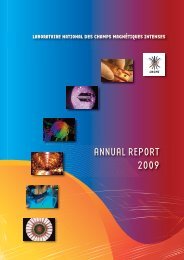Laboratoire National des Champs Magnétiques Pulsés CNRS – INSA
Laboratoire National des Champs Magnétiques Pulsés CNRS – INSA
Laboratoire National des Champs Magnétiques Pulsés CNRS – INSA
Create successful ePaper yourself
Turn your PDF publications into a flip-book with our unique Google optimized e-Paper software.
Personnel involved:<br />
Organic conductors<br />
Permanents: A. Audouard (CR1), M. Nardone (IR), D. Vignolles (MC)<br />
Collaborations: V.N Laukhin, E. Canadell (ICMAB Barcelona)<br />
R.B. Lyubovskii, R.N. Lyubovskaya, E.B. Yagubskii (IPCP, Chernogolovka)<br />
J.-Y. Fortin (<strong>Laboratoire</strong> Physique théorique, Strasbourg and Institut Jean Lamour, Nancy)<br />
Due to their rather simple Fermi surface (FS), organic metals provide a powerful playground for the<br />
investigation of quantum oscillation physics. Indeed, in most cases, their FS can be regarded as networks of<br />
orbits coupled by magnetic breakdown (MB) giving rise to quantum oscillations spectra with numerous<br />
frequency combinations that cannot be accounted for by the semiclassical model of Falicov and Stachowiak.<br />
This phenomenon which is attributed to either the formation of Landau bands or (and) the oscillation of the<br />
chemical potential in magnetic field needs to be better understood.<br />
Frequency combinations in linear chains of orbits with high scattering<br />
rate<br />
The FS of (BEDO) 5Ni(CN) 4·3C 2H 4(OH) 2 (see the opposite figure)<br />
corresponds to a linear chain of quasi-two-dimensional orbits coupled by<br />
MB. Remarkably, the scattering rate can be consistently deduced from the<br />
Shubnikov-de Haas oscillations data relevant to both the basica, the second<br />
harmonic 2a and the MB-induced b orbits. Its large value points to a<br />
significant reduction of the chemical potential oscillations. Despite of this<br />
feature, the oscillations spectrum exhibits many frequency combinations [1].<br />
Their effective masses and (or) Dingle temperature are not in agreement<br />
with neither the predictions of the quantum interference model nor the<br />
semiclassical model.<br />
Frequency combinations in networks of compensated orbits<br />
According to calculations [2] chemical potential oscillations are strongly<br />
reduced for 2D metals with compensated orbits. 2D networks of<br />
compensated orbits are achieved in the compound (ET) 8[Hg 4Cl 12(C 6H 5Br) 2]<br />
as displayed in the opposite figure where the two a orbits with different<br />
shapes are compensated while thed and D pieces are forbidden orbits. In<br />
agreement with the above statement, all the frequency combinations<br />
observed in early de Haas-van Alphen (dHvA) oscillations spectra up to 28<br />
T data are consistent with the semiclassical picture [3]. Oppositely, recent<br />
dHvA data obtained from torque measurements up to 55 T exhibit many<br />
frequency combinations, most of them being forbidden within the<br />
semiclassical framework [4]. Otherwise, the pressure dependence of the<br />
effective mass linked to the basic a orbits scales with the coefficient of the T² law of the zero-field resistance<br />
which is in line with a Brinkman-Rice scenario expected for strongly correlated compounds [5].<br />
References<br />
[1] D. Vignolles et al., Eur. Phys. J. B. 55 383 (2007).<br />
[2] J.-Y. Fortin and A. Audouard, Phys. Rev. B 77 134440 (2008).<br />
[3] A. Audouard et al. EPL 71 783 (2005).<br />
[4] D. Vignolles et al., in preparation<br />
[5] D. Vignolles et al., Eur. Phys. J. B. 66 489 (2008).<br />
20







